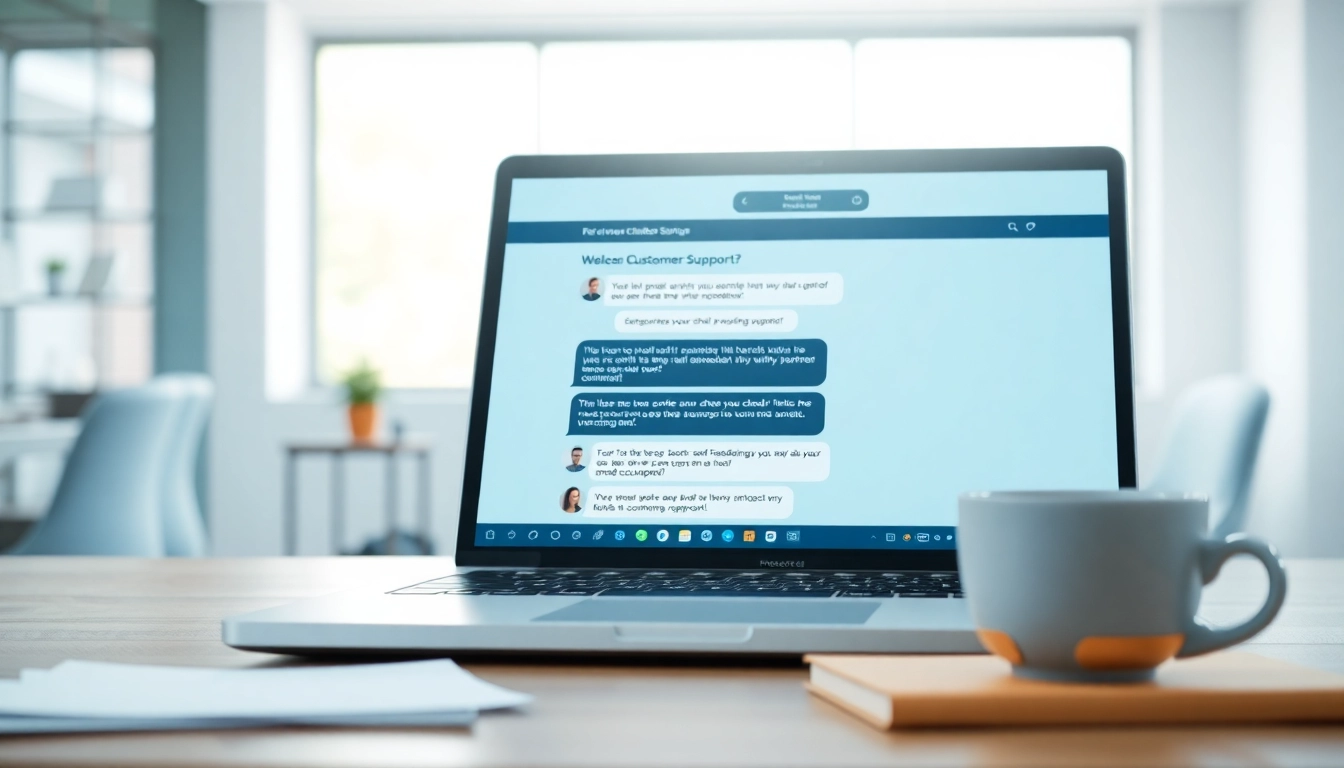1. Understanding the Role of a Chatbot for Website
1.1 What is a Chatbot? An Overview
In the rapidly evolving digital landscape, communication with customers has transitioned from traditional methods to more innovative solutions. A chatbot is an artificial intelligence (AI) tool designed to simulate conversations with users through messaging interfaces. These bots can operate using pre-defined scripts or machine learning algorithms, which equip them to understand, process, and respond to user inquiries effectively. As businesses strive to enhance customer engagement on their platforms, integrating a chatbot for website has emerged as a pivotal strategy.
1.2 Benefits of Using a Chatbot for Your Website
Integrating a chatbot into your website offers multiple advantages that can enhance user experience, improve operational efficiency, and boost sales. Here are some key benefits:
- 24/7 Availability: Unlike human staff, chatbots can operate around the clock, providing immediate responses to user queries at any time of the day.
- Cost Efficiency: Chatbots can handle thousands of inquiries simultaneously, reducing the need for large customer service teams and thereby cutting operational costs.
- Improved User Experience: Users receive instant responses to their questions, leading to higher satisfaction and engagement rates.
- Lead Generation: Chatbots can assist in qualifying leads through conversations, ultimately facilitating the sales process.
- Data Collection: They can gather valuable insights through interactions, which can be utilized to enhance marketing strategies and improve service offerings.
1.3 Common Use Cases of Chatbots in Websites
Chatbots serve numerous functions across various industries. Some common use cases include:
- Customer Support: Offering answers to frequently asked questions or troubleshooting technical issues.
- E-commerce: Guiding customers through product catalogs, assisting with order placements, and tracking orders.
- Appointment Scheduling: Allowing users to book services or schedule appointments without human intervention.
- Content Delivery: Sending personalized content, such as blogs or updates, based on user preferences.
- Feedback Collection: Gathering user feedback to improve products, services, or user experience.
2. Choosing the Right Chatbot Solution for Your Website
2.1 Key Features to Look for in Chatbots
When choosing a chatbot solution for your website, several key features should guide your decision:
- Natural Language Processing (NLP): This allows the bot to understand and interpret user inputs in a conversational manner, enhancing interaction quality.
- Integration Capabilities: The chatbot should seamlessly integrate with existing systems, like CRM tools, to enhance functionality and streamline processes.
- Customizability: Look for bots that can be tailored to reflect your brand’s voice and personality.
- Analytics and Reporting: This feature enables you to track interactions, user satisfaction, and performance metrics, essential for ongoing improvement.
- Multilingual Support: If you have a diverse audience, a chatbot that supports multiple languages can help serve those users better.
2.2 Comparing Popular Chatbot Platforms
Selecting the right platform for your chatbot solution can significantly impact its performance and user experience. Here are a few popular platforms worth considering:
- Dialogflow: Powered by Google, this platform excels in natural language processing and is ideal for developers looking to create advanced chatbots.
- ManyChat: Best suited for marketing automation, ManyChat allows businesses to automate interactions on platforms like Facebook Messenger.
- Chatfuel: Known for its user-friendly interface, Chatfuel is perfect for non-technical users aiming to build chatbots quickly without coding.
- Zendesk Chat: Integrating seamlessly with the Zendesk support platform, this chatbot is great for enhancing customer service experiences.
- Intercom: This platform combines live chat and automation, making it ideal for businesses focused on customer engagement and support.
2.3 Custom vs. Off-the-Shelf Chatbot Solutions
Choosing between custom and off-the-shelf chatbot solutions largely depends on your business goals and resources. Here’s a breakdown of both options:
- Custom Chatbots: Tailored to your specific needs, custom solutions can be highly effective but require more time and investment. They offer flexibility, extensive integration options, and can align perfectly with your branding.
- Off-the-Shelf Chatbots: These solutions provide a quicker route to implementation and often come with standard features, making them budget-friendly. However, they may lack certain customizations unique to your business.
3. Implementation Steps for Chatbots on Websites
3.1 Setting Up Your Chatbot
The implementation process for a chatbot typically involves several steps:
- Define Objectives: Identify the problem your chatbot will address—whether it’s customer support, lead generation, or another area.
- Choose a Platform: Select the chatbot platform that best suits your needs and level of technical expertise.
- Design Conversation Flows: Map out how conversations will unfold, including potential user questions and appropriate responses.
- Integrate with Your Website: Utilize APIs or plugins provided by your chosen chatbot platform to embed the bot into your website.
- Test Functionality: Before going live, conduct thorough testing to ensure the bot operates smoothly and effectively handles expected queries.
3.2 Best Practices for Integration
Effective integration of chatbots into your website is crucial for successful user interactions. Consider the following best practices:
- Contextual Placement: Position the chatbot in locations where users are likely to need assistance, such as on product pages or contact forms.
- Use Clear Calls to Action: Encourage users to engage with the chatbot by using clear and inviting prompts.
- Optimize for Mobile: Ensure the chatbot is mobile-responsive, as a significant portion of users will access your site via smartphones.
- Maintain a Human Touch: Allow users to escalate to a live representative when necessary, as complex queries may require human interaction.
3.3 Testing and Optimization Techniques
Regular testing and optimization are essential to maintain the effectiveness of your chatbot. Here are some techniques:
- Conduct A/B Testing: Experiment with different conversation flows and response options to determine what yields the best results.
- Gather User Feedback: Implement mechanisms to collect user feedback on their experiences with the chatbot, providing insights into where improvements are needed.
- Monitor Performance Metrics: Keep an eye on key performance indicators like response times and resolution rates to assess the effectiveness of your chatbot.
- Regularly Update Content: Keep the chatbot’s knowledge base updated with new information about products, services, or policies to maintain relevance.
4. Enhancing User Experience with Chatbots
4.1 Personalization Strategies for Chatbot Interactions
Personalization can significantly enhance user experience and engagement. Here are strategies to make chatbot interactions more personalized:
- User Profiles: When users register, collect data that can be used to tailor future interactions based on their previous engagements.
- Dynamic Responses: Use collected data to adjust responses based on user behavior and preferences, making interactions feel more relevant.
- Proactive Engagement: Reach out to users with personalized messages or recommendations based on their browsing history or preferences.
4.2 Utilizing Chatbots for Customer Feedback
Collecting customer feedback through chatbots is an effective way to enhance your offerings. Here’s how to do it:
- Post-Interaction Surveys: After resolving inquiries, encourage users to provide feedback on their experience with the chatbot.
- Contextual Questions: Use the chatbot to ask specific questions regarding user experience immediately after service interaction.
- Incentivized Feedback: Consider offering small rewards, such as discounts or bonuses, to motivate users to share their opinions.
4.3 Aligning Chatbots with Brand Messaging
Ensuring that your chatbot reflects your brand’s voice and values creates a cohesive user experience. Here are tips for alignment:
- Tone and Language: Define a consistent tone that matches your brand, whether it’s professional, friendly, or quirky.
- Visual Elements: Customize the chatbot’s appearance using colors, fonts, and logos that align with your overall branding.
- Brand-Specific Knowledge: Ensure the chatbot is well-versed in your products, services, and company values, allowing for informed user interactions.
5. Measuring the Success of Your Website Chatbot
5.1 Key Performance Indicators to Track
Measuring the success of your chatbot is essential for continuous improvement. Here are key performance indicators (KPIs) to consider:
- Response Time: Monitor how quickly the chatbot responds to inquiries, as speed is crucial for user satisfaction.
- Resolution Rate: Track the percentage of inquiries resolved by the chatbot versus those escalated to human agents.
- User Retention: Analyze how often users return to interact with the chatbot, indicating its effectiveness in providing value.
- Engagement Rate: Assess the number of users who interact with the chatbot compared to the total visitors to your website.
5.2 Analyzing User Engagement Metrics
Understanding how users engage with your chatbot can provide valuable insights. Consider these metrics:
- Conversation Length: Measure how long users are engaged in conversations, as longer interactions might indicate more complex inquiries or higher engagement.
- Drop-off Points: Identify where users abandon conversations, signaling potential issues or areas for improvement.
- Frequently Asked Questions: Track common queries to enhance your chatbot’s knowledge base and improve its capabilities.
5.3 Adjusting Strategies Based on Analytics
Data-driven decisions are critical for optimizing chatbot performance. Here’s how to adjust strategies based on analytics:
- Regular Review of KPIs: Schedule periodic reviews of performance metrics to identify trends and areas needing attention.
- User Feedback Implementation: Act on feedback received from users to improve responses and overall functionality.
- Continuous Learning: Regularly update the chatbot’s training data with new information and conversation strategies to enhance understanding.






